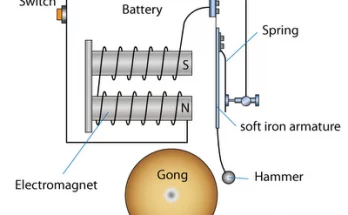Chapter 14- Electric Current and Its Effects- Fill in the Blanks with Answers and Explanations (Solved Worksheet)
Question- Electric current is the flow of electricity through a __________, such as wires and cables.
Answer- Conductor
Explanation- A conductor is a material which allows electricity to flow through it, similar to how water flows through a pipe.
Question- Electricity is generated at __________, which can be considered ‘electricity factories’.
Answer- Power stations
Explanation- Power stations are the facilities where electricity is produced before being transmitted to different places like homes and schools.
Question- In a simple electric circuit, a __________ shows if electricity is flowing by lighting up.
Answer- Bulb
Explanation- A bulb in a circuit lights up when electricity flows through it, indicating that the circuit is complete and functional.
Question- When the switch is OFF, the circuit is __________, preventing the flow of electricity.
Answer- Open
Explanation- An open circuit means the path for electricity is broken, which stops the flow of current, keeping the bulb off.
Question- In a circuit diagram, a cell or battery is represented by __________ lines, indicating positive and negative terminals.
Answer- Parallel
Explanation- Parallel lines in a circuit diagram symbolise the positive and negative terminals of a cell or battery, which are essential components of the circuit.
Question- A single electric cell typically provides around ______ volts of electricity.
Answer- 1.5
Explanation- A standard electric cell provides 1.5 volts, which is significantly lower than the voltage supplied from power stations.
Question- In a series connection of cells, the positive terminal of one cell is connected to the ______ terminal of another.
Answer- Negative
Explanation- Connecting the positive terminal of one cell to the negative terminal of another in series increases the overall voltage.
Question- When cells are connected in parallel, the ______ of the cells increases.
Answer- Capacity
Explanation- Parallel connection of cells increases their capacity, which means they can provide power for a longer duration, but the voltage remains the same.
Question- The heating effect of electric current is influenced by the ______ of the wire.
Answer- Resistance
Explanation- The heating effect is greater in wires with higher resistance, as they convert more electrical energy into heat.
Question- The magnetic effect of electric current was discovered by ______.
Answer- Hans Christian Oersted
Explanation- Oersted’s discovery revealed the link between electricity and magnetism by showing that a current-carrying wire affects a compass needle.
Question- Lightning is a natural phenomenon that occurs during thunderstorms and is a spectacular display of electric ________.
Answer- Discharge
Explanation- Lightning is the result of electric discharge that occurs when there’s a significant buildup of electric charges during a storm.
Question- Lodestones are pieces of naturally magnetised mineral ________, and their magnetic properties are often attributed to lightning strikes.
Answer- Magnetite
Explanation- Lodestones are naturally occurring magnets made of the mineral magnetite, and their magnetism is believed to be induced by lightning strikes.
Question- In an electric bulb, light is produced when electric current passes through the ________, causing it to glow.
Answer- Filament
Explanation- The filament in an electric bulb heats up and glows due to the heating effect of electric current, thereby producing light.
Question- In electrical circuits, a fuse is used to prevent excessive current flow and is made of a material that ________ easily.
Answer- Melts
Explanation- Fuses are designed with materials that melt quickly when excessive current flows through them, thereby breaking the circuit and preventing hazards.
Question- In an electric bell, when the circuit is completed, the electromagnet gets magnetised and attracts the ________ towards itself.
Answer- Armature
Explanation– The electric bell works on the principle of electromagnetism, where completing the circuit magnetises the electromagnet, which then pulls the armature and causes the bell to ring.
Question- An electromagnet becomes magnetised only when _______ passes through the coil.
Answer- Electric current
Explanation- The magnetic field in an electromagnet is produced by the flow of electric current through its coil, magnetising the iron core.
Question- The strength of an electromagnet can be adjusted by changing the amount of _______ flowing through the coil.
Answer- Current
Explanation- The magnetic strength of an electromagnet is controllable by varying the electric current flowing through its coil.
Question- A short circuit occurs when the insulation of live and neutral wires wears out, causing them to come into _______.
Answer- Direct contact
Explanation- A short circuit is a hazardous situation where worn-out insulation leads to direct contact between live and neutral wires, causing a dangerous flow of current.
Question- A fuse consists of a thin wire with a low _______ point.
Answer- Melting
Explanation- Fuses have a thin wire that melts easily when overheated due to excessive current, thereby breaking the circuit and preventing hazards.
Question- Appliances with the _______ mark are considered safe and efficient in terms of electricity usage.
Answer- ISI
Explanation- The ISI mark on an electrical appliance indicates compliance with the safety and quality standards set by the Indian Standards Institute.
Also Check- Chapter 10 – Electric Current and its Effects – 5 Worksheets Solved and Unsolved
Also Check- Batteries- The Powerhouses of Everyday Life – A Guide for Upper Primary Students
Also Check- Electromagnets- A Guide for Upper Primary Students
Also Check- Electric Bell Diagram for Class 7 Science
Also Check- Rapid Revision – Class 7 Science- Chapter 14 – Electric Current and Its Effects
Also Check- Chapter 14- Electric Current and Its Effects-Class 7 science- Question and Answers
Also Check- Chapter 14- Electric Current and Its Effects–Class 7 science- Question and Answer -(Solved MCQs)
Also Check- NCERT Exemplar Solutions- Class 7 Science- Chapter 14 – Electric Current and Its Effects
Also Check- NCERT Solutions for Class 7 Science Chapter 14- Electric Current and its Effects
Also Check- Class 7 science -Chapter 14 – Electric Current and Its Effects- Complete Notes
